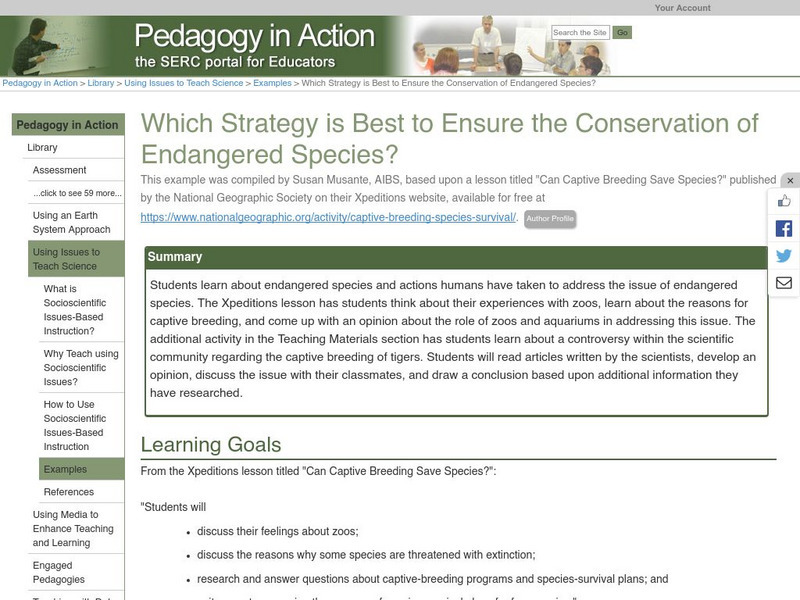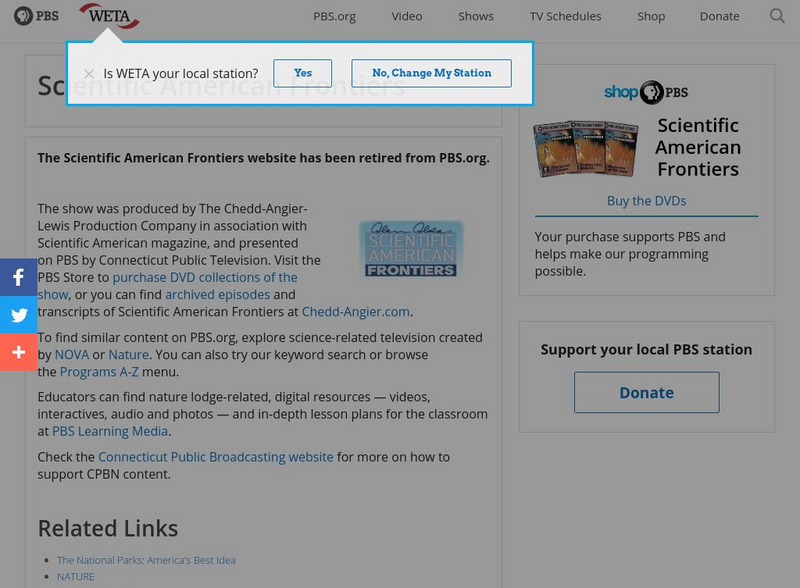Curated OER
Bison Eating
Fifth graders use metric measurement to study the amount a bison eats. In this measurement lesson, 5th graders watch a video about bison and discuss the amount of food they eat. Students weigh their food trays at lunch and complete a...
Smithsonian Institution
National Museum of Natural History: Zoo Labs
Five inquiry-based investigations designed for the observation of primates in a zoo setting. The labs ask guiding questions and list notable primate behaviors.
Council for Economic Education
Econ Ed Link: If I Ran the Zoo Economics and Literature
Welcome to the Zoo! In this two-day lesson you will use Dr. Seuss' If I Ran The Zoo book to introduce the economic concepts to your learners. You will also get the chance to use actual zoo criteria to help a zoo "choose" new animals.
Smithsonian Institution
Smithsonian Education: Art to Zoo What Can You Do With a Portrait?
This is the very first published issue of Art to Zoo. Unlike later issues, it features three separate topics instead of one larger theme. In this issue you can find information and resources for teaching westward expansion and its impact...
Writing Fix
Writing Fix: Action Packed Zoo Sentences
In this lesson, If I Ran the Zoo, written by Dr. Seuss, is used as the mentor text. Students will record their favorite adjectives from the mentor text, rank them according to their favorite, and share them. Students will also use...
A to Z Teacher Stuff
A to Z Teacher Stuff: Animal Alphabet: Kindergarten Zoo Abc Review
A lesson plan where students work together to create a Kindergarten Zoo hall display or alphabet book while learning the alphabet.
Smithsonian Institution
Smithsonian Education: Art to Zoo Playing Historical Detective
Students become detectives, reading and analyzing documents and artifacts as clues to the life of a nineteenth century woman, Annie Steel. The students then use various materials to create a series of collages.
Smithsonian Institution
Smithsonian Education: Art to Zoo Memorials: Art for Remembering
The lessons in this issue familiarize students with memorials in which they examine four memorials from around the world and examples in their own community. In a culminating activity, students identify and create a memorial for someone...
PBS
Pbs Teachers: Scientific American: The New Zoos: Polar Bear Picnic
Explore zoos and the change in animal care, and research the physiology and habitats of polar bears. Investigate the difference between what is essential to survive and what is desirable in an enriched environment.
Smithsonian Institution
Smithsonian Education: Art to Zoo Spinning Yarns, Telling Tales About Textiles
A great resource for introducing different types of textiles and weavings to your students. A good amount of background information is included as well as a few simple learning activities.
Smithsonian Institution
Smithsonian Education: Art to Zoo the Museum Idea 1976
Some ideas for you to try before making a visit to a museum of any kind. Also included are a worksheet for young scholars to research various museum careers and a fun article about abstract art.
Smithsonian Institution
Smithsonian Education: Art to Zoo: House Keys
Ideas for teaching and learning about Victorian architecture in the United States, both interiors and exteriors. Although directed to teachers, House Keys compiles much useful information of interest to anyone studying the design of...
Smithsonian Institution
Smithsonian Education: Art to Zoo Kiting Up the Sky
This article provides a brief outline on the history of kites as well as information on the forces of kite flight. There are a couple lesson plans included. One lesson directs students in writing kite poems. The other includes...
ReadWriteThink
Read Write Think: Webcams in the Classroom: Animal Inquiry and Observation
Observe animal behavior patterns and their habitats using one of the many webcams broadcasting from zoos and aquariums around the United States and the world in this inquiry-based activity that focuses on observation logs, class...
Writing Fix
Writing Fix: We Saw Him at the Zoo
In this lesson plan, the mentor text utilized is Deborah Guarino's book, Is Your Mama a Llama?, with the focus of sentence fluency. Each student will think of an animal that that has the same initial sound as his/her name. Using the...
PE Central
Pe Central: K 2 Pe Lesson Ideas: Zoo Parade Days
Students able to throw and catch, and who are able to shoot and pass a basketball are ready to play "Zoo Parade Day." This activity requires students to work in different "centers" or stations throughout the gym and to demonstrate...
Science Education Resource Center at Carleton College
Serc: Which Strategy Is Best to Ensure the Conservation of Endangered Species?
This lesson is an exploration of the topic of captive breeding in zoos and aquariums, and whether this is the best option for preserving endangered species. (The National Geographic lesson referenced on this page has been archived. This...
Alabama Learning Exchange
Alex: Reading and Writing About Miss Moo
Lesson for early elementary and special education students utlizing the book Miss Moo Goes to the Zoo by Kelly Graves and graphic organizers to identify elements in a story (title, author, setting, characters, etc.). Students participate...
Alabama Learning Exchange
Alex: What Is Your "Bat"itude?
This lesson is for use at the beginning of a unit on bats to help determine students' previous knowledge about bats as well as their bat attitudes. Students will begin by drawing an illustration describing their feelings about bats....
PBS
Pbs Teachers: Scientific American: The New Zoos: Doctor Fish
Investigate the evolution of the heart and circulatory system in mammals by studying the anatomy of hearts in other animals. Create models of the hearts of fish, amphibians and mammals.
PBS
Pbs Teachers: Scientific American: The New Zoos: Tuna in the Tank
Investigate how scientists track the world's most valuable and endangered fish. Define the range of an individual based on observations made over the course of a day.
PBS
Pbs Teachers: The New Zoos: The Wilder, the Better
Investigate how scientists study the mirror self-recognition of orangutans. Perform an experiment to see how sense of self can become distorted when a reflection doesn't match the sense of body position and movement.
Smithsonian Institution
Smithsonian Education: Art to Zoo: Landscape Painting
This lesson plan uncovers the "tricks" artists use when creating a landscape painting. Students will explore the work of American artists George Catlin, Albert Bierstadt, Thomas Moran, and Winslow Homer. One of the activities is in spanish.
Other
Adopt a Pond Wetland Curriculum Resource
The Adopt-A-Pond Program was created by the Toronto Zoo for teachers looking for a guide to wetland issues and resources.
Other popular searches
- Zoo Animals
- Zoo Animals Habitats
- Zoo Animals Thematic Unit
- Theme Zoo Animals
- Zoo Animals Math
- Bronx Zoo
- Describing Zoo Animals
- Farm and Zoo Animals
- Zoo Animals Problem Solving
- Zoo Animals Coloring
- Zoo Animals Lesson Plans
- Zoo Animals Pre K
















